It’s official. The North American music festival market is oversaturated. Over the last two years it has reached a tipping point, as a swath of festivals have either bowed out or been left on indefinite hiatus.
In the Pacific Northwest, the mighty Sasquatch! has vanished. In Houston, Day For Night has been left in the dark. In New York City, Panorama is nowhere to be seen. In Los Angeles, FYF might as well stand for “Forget Yo’ Festival.” In Canada, if you wanted to take a Field Trip or needed to find your Way Home, you would be shit out of luck. Up north, the sun has set on Summer Set. Last month in Chicago, Mamby On The Beach went to the birds. Most famously, Woodstock 50 never got out of the mud.
This summer, no festival was missed more—at least in my heart—than the Eaux Claires Music & Arts Festival.
What began in 2015 as an artist-curated festival headlined by two great bands—Bon Iver and The National—became a mind-expanding and life-affirming annual pilgrimage to the hometown of Wisconsin’s most revered rockstar, Justin Vernon.
Eaux Claires took risks, pushed boundaries and redefined the form, fostering a devout community of artists and fans along the way.
The festival was a critical success and left a significant cultural and economic impact on the region, but it lost money after the first year. It also got some negative press for keeping its 2018 lineup a secret and emphasizing new, improvised, and experimental music. As a result, Eaux Claires took 2019 off to recalibrate and restructure.
Having covered all four iterations of the festival for three different publications, I was compelled to continue my streak. But how do you write about a festival that didn’t happen? And why?
Well, of all the music festivals taking a break this year, Eaux Claires is the only one that has pledged to return in 2020. No information has been shared beyond a relocation from the woods to downtown Eau Claire, but there are promising signs, like the new, state-of-the-art Pablo Center At The Confluence.
And so, back in June, on the way to a friend’s wedding in northern Minnesota, I stopped in Eau Claire and met with Jason Jon Anderson, executive director of the Pablo.
While waiting in the lobby for Anderson, I noticed that Francis And The Lights was scheduled to play the Pablo that weekend. During our conversation, Anderson mentioned that Francis had been utilizing the building all week for rehearsals. When we finished our tour, Anderson led me to a recital hall.
There, sitting in front of a grand piano, was the elusive artist known as Francis Farewell Starlite.
Outside of Justin Vernon, no one has come to embody the spirit of Eaux Claires quite like Francis. He is a guarded individual who rarely speaks to the media, but that afternoon, as we overlooked where the Eau Claire River and Chippewa River meet, Francis spoke passionately about Eaux Claires.
Our conversation underscores what makes the festival singular and why its energy will endure.
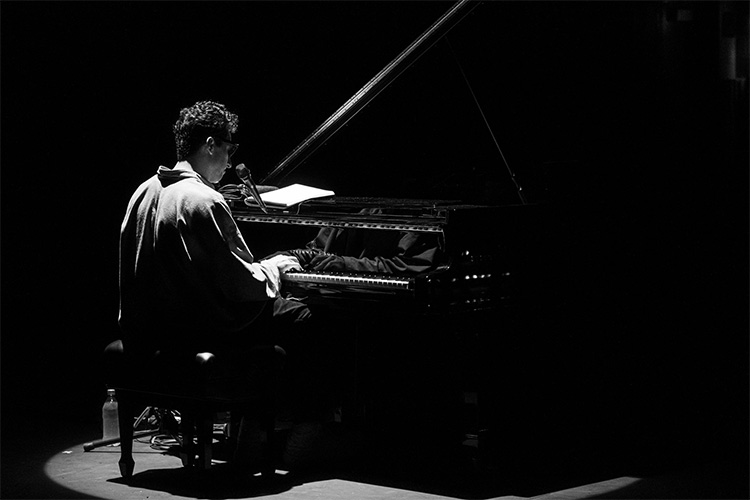
Photo: Lee Butterworth
It is Friday, July 17, 2015. I am running up a hill at Foster Farms, a 120-acre property nestled in the Town of Union, just outside of Eau Claire. I don’t know what I will find at the top. I could look at the Field Guide I was handed on my way into the inaugural Eaux Claires, but I am in the mood for discovery.
When I reach the top of the hill, I see the incandescent Melissa Viviane Jefferson, better known as Lizzo. She is walking towards a van and waving at fans. Later that night she will perform a brief but scintillating set, foreshadowing her ascent to global stardom.
“What ya’ll know about Eau Claire?” Lizzo asked the audience at her triumphant Summerfest set a few months ago.
Back in 2015, I knew very little. Thanks to Eaux Claires, I now have a feel for the region, its people, and its history. Yet it is the unknown that continues to draw me back to the Chippewa Valley.
“It’s this beautiful thing happening in this sort of unexpected place,” Francis told me.
“Eau Claire is one of the most beautiful places I’ve ever been in my life. It would always knock me out, especially this time of year.”
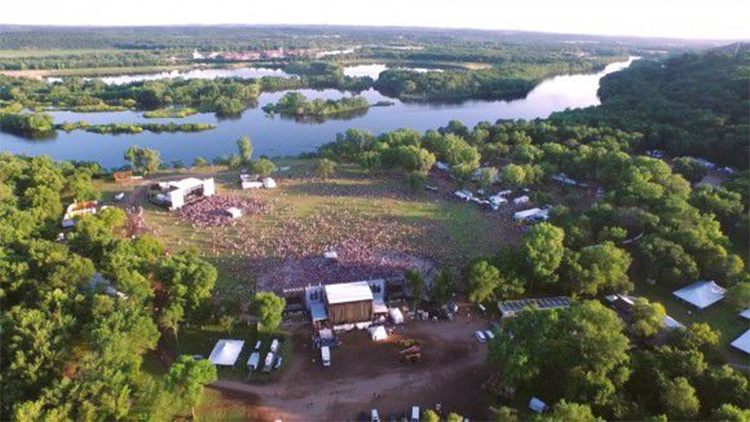
Photo: Volume One
According to Zane Lowe’s recent interview with Justin Vernon for Apple Music, Francis actually lived in Eau Claire for a few years. At that point, Francis’ career was in a rut and according to Vernon, he was living in a mail van. Vernon invited him to Eau Claire, where Francis was able to center himself and reignite his career.
“Eau Claire was really the jumping off point of this phase of my music life,” said Francis, who, on the first night of the inaugural Eaux Claires, was spazzing out 50 feet in the air on a scissor lift while Lizzo was twerking in the upper field.
“Justin gave me this incredible slot after The National. In a sense, Justin and the whole crew were like ‘Hey, let’s give this kid a chance.'”
Vernon’s career has also been given new life since the festival began. Following Bon Iver’s two awards at the 2012 Grammys and a high-profile collaboration with hip-hop icon Kanye West, Vernon was left feeling hyper-exposed. As a result, he struggled with anxiety and isolation. It was during this time that Vernon nearly abandoned the Bon Iver project.
Eaux Claires allowed Vernon to bring Bon Iver back on his own terms, in his own town, guaranteeing the success of the first festival.
Four years later, Vernon, the Bon Iver band, and an ever-expanding group of collaborators—many of whom Vernon met or deepened his relationship with at Eaux Claires—have given the world two masterful, genre-melting albums: 2016’s 22, A Million, which debuted at the second Eaux Claires, and this year’s i, i.
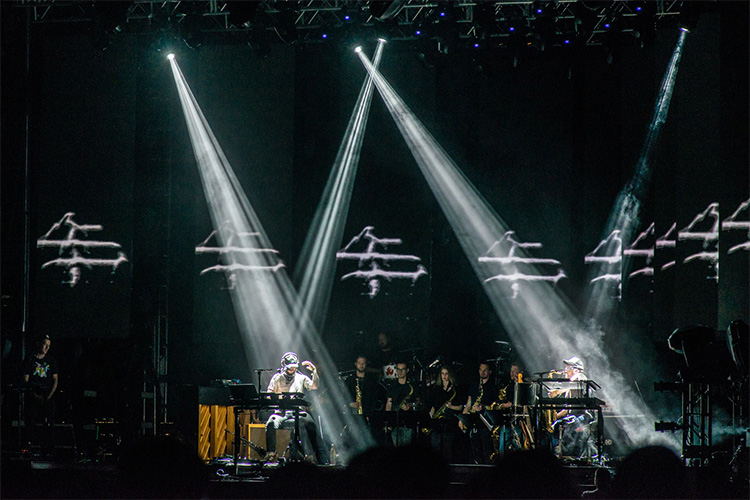
Photo: Graham Tolbert
It is Saturday, August 12, 2016. I am running across the upper field to get a spot for Francis And The Lights’ festival closing set at Eaux Claires Deux. There is a rumor that Chance The Rapper, who headlined nearby Summer Set the night before, will make a surprise appearance.
A security guard makes his way to the front of the stage. He is wearing a hat with the same four stars as the Chicago city flag, Chance’s hometown. My heart skips a beat.
“That was one of the greatest moments of my life,” said Francis about bringing out his friend Chance at EXC II.
If Eaux Claires has a theme song, it is “Friends” by Francis And The Lights featuring Bon Iver and Kanye West. In the video, Francis and Vernon do a synchronized dance, which Chance joined them for during his surprise appearance and the next summer at his own headlining set.
“What they tried to do, what they did do, is give you a magical experience,” said Francis. “Something unexpected, something exceeding expectations.”
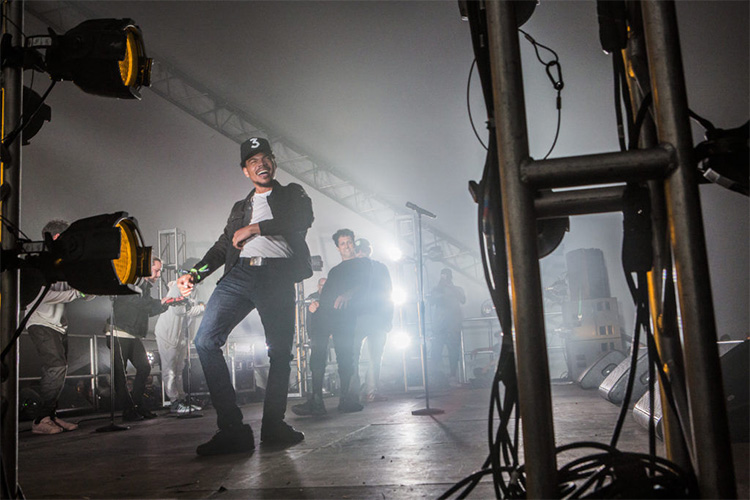
Photo: David Szymanski
It is Saturday, June 17, 2017. I am running across the field to see Collections Of Colonies Of Bees at Eaux Claires Troix. While some bands might scoff at a noon slot, Milwaukee’s Chris Rosenau is ecstatic about opening the second day of the festival. Rosenau is a member of another Vernon project, Volcano Choir. At the first two festivals Rosenau performed solo and as a duo with Nick Sanborn of Sylvan Esso.
“When I was driving home after the [second] Eaux Claires I thought this might be an interesting place to do a more full-band type of thing,” said Rosenau, who then reimagined the Bees lineup, adding the marvelous Marielle Allschwang.
“So I texted Justin and asked if I got the Bees back together and wrote a record specifically for the fest would he be interested, and he said sure.”
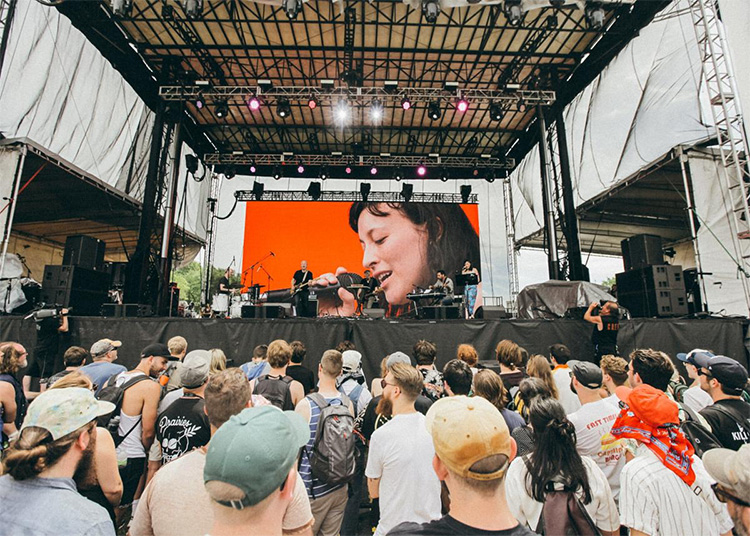
Photo: Joe Kirschling
Milwaukee mainstay Mark Waldoch, Rosenau’s guitar tech and a fantastic musician in his own right, has been a regular at Eaux Claires. He performed a pop-up show in the woods in 2015 that I am still kicking myself for missing. The following year, I sat down with Waldoch the week after EXC II.
“There’s no other festival like it! I feel like a kid at the end of summer having to go back to school. Just like, ‘Awww, the weekend was so great. I don’t want to go back to my life!’ But on the other hand, it’s also intensely, stupefyingly inspiring to go out and make music now. It had the same effect last year. I had this explosion of creative energy.”
At Eaux Claires IV, Waldoch sang with Milwaukee’s Field Report, another Eaux Claires staple. Field Report actually kicked-off the inaugural festival. Lead singer Christopher Porterfield and Justin Vernon go back to their college days—both were in the band DeYarmond Edison while studying at UW-Eau Claire.
On the eve of EXC III, Field Report performed at a street festival in downtown Eau Claire called OXBEAUX. It was held outside of The Oxbow Hotel, which Vernon helped open in 2016.
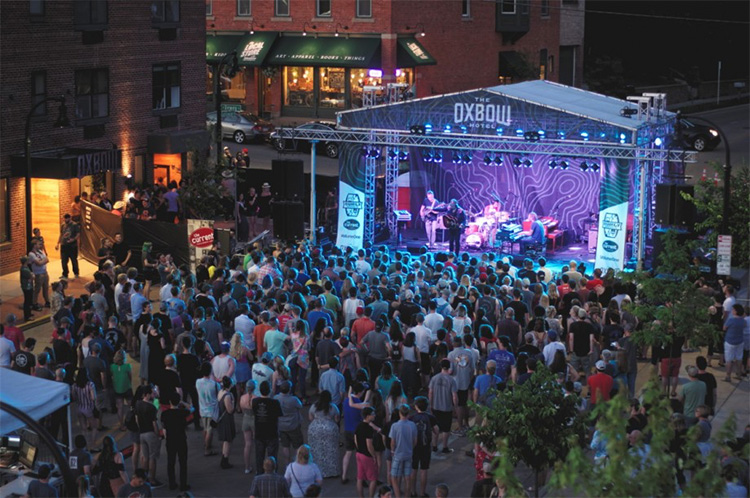
Photo: Luong Huynh / Volume One
While Field Report was playing, I walked up to Eaux Claires co-curator Aaron Dessner of The National with my fiancée, Milwaukee-based artist Kristina Rolander, who is best known her for her hand-painted, black and white backdrop that has been up at Cactus Club since 2017. She wanted to thank Dessner for having her at the festival, as she created artwork for The Creek stage that year. It wasn’t long before he was showing us pictures of his kids.
The next day, Dessner, Vernon, and friends opened EXC III at The Creek stage with a performance called “PEOPLE Mix Tape Vol. 1.” It was an introduction to the 37d03d collective, which grew out of an experience at Berlin’s Funkhaus in 2016. The collective has since created a free, non-commercial website for sharing new and unreleased music, returned to Berlin in 2018, and held a mini-festival in Brooklyn this past May. Each public performance is rooted in a week-long residency beforehand.
Later that day at EXC III, Francis played The Creek stage. The next day, Dessner and Vernon debuted a work-in-progress project called Big Red Machine at The Creek.
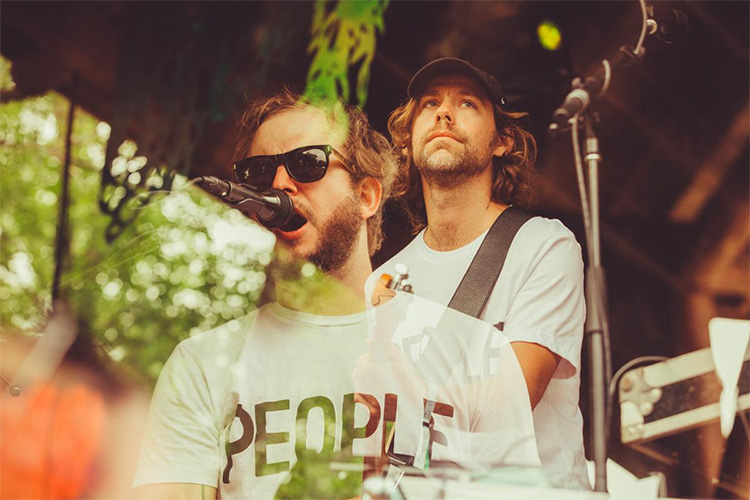
Photo: Scotify
“Twenty years from now people at EXC3 will realize they saw Justin and Aaron creating new music together, in the moment, live in front of an audience,” wrote Eaux Claires creative director Micheal Brown on Twitter ahead of EXC IV.
“The bravery and guts to do that is inspiring. Eaux Claires is an incubator and now those projects are breathing life. Look past the performance aspect of it all and realize you’re being invited to witness and experience a process that is complex and guarded for good reasons,” Brown added.
Ahead of EXC III, I spoke with Brown, a Nashville native and self-described “Justin Vernon import” who moved to Eau Claire for the first two years of the festival.
“From when I arrived in Eau Claire to where I see it now, there has been massive amounts of change. I see a beginning more importantly in a change of attitude, in what people realize can happen,” said Brown.
In tandem with the first OXBEAUX, the local business community put together Prex Claires, a downtown concert series, which was expanded on in 2018.
Yet, not all locals embraced the festival. Some residents in the Town of Union complained about the volume and tried to have the festival shut down. This contributed to the closing of the upper field in 2017 and 2018.
Milwaukee Record‘s resident Eaux Claires reviewer, Cal Roach, wrote in 2017, “It’s almost as if they’ve deliberately tried to keep it small and discourage developing a brand.”
The first part of Cal’s theory would prove correct. In an interview with a fan publication that was distributed on the grounds at EXC IV, Brown admitted, “We want the festival to be smaller. We don’t want more people. We want less people.”
While the festival purposefully downsized in its third year, it also booked some of its biggest names to date—Paul Simon, Wilco and Chance The Rapper—setting up lofty expectations for its no-lineup gamble in 2018.
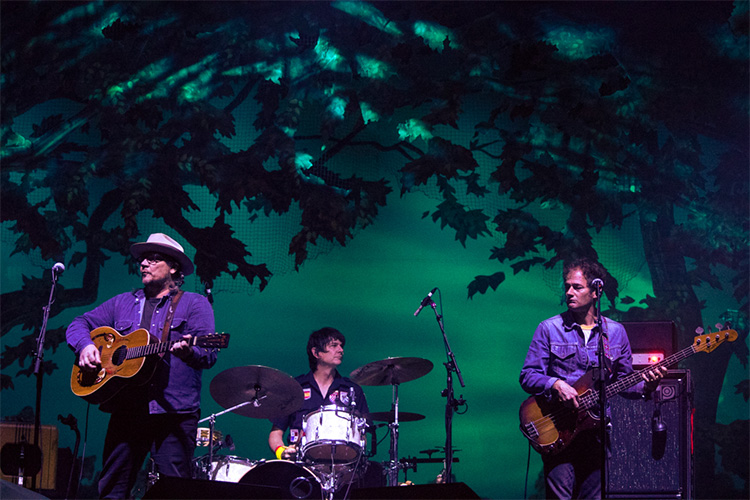
Photo: Lesley Keller
It is Saturday, July 7, 2018. I am running through the woods to see something called “Broder Mix Tape” at Eaux Claires IV. Photographer Kelly Michael Anderson insists that we check out whatever Minneapolis musician Andrew Broder has to offer. When we arrive, I spot Los Angeles singer/songwriter Phoebe Bridgers—one of the most talked-about artists at the festival—standing by the side of the stage.
Minutes later, Julien Baker, another incredible singer/songwriter who would go on to form the supergroup boygenius with Bridgers and Lucy Dacus, strolls up.
Baker and Bridgers each perform their own set on the main stages, but on that small stage in the woods, in front of no more than 200 people, they take turns performing their songs while Broder provides a digital back beat. Members of the indigenous group Iron Boy also perform with Broder, inspiring the audience to dance. It is one of the most unexpected, intimate, and joyous Eaux Claires experiences.
In this way, EXC IV can be understood as a tale of two festivals. On the one hand, there were the performances on the main stages in the open field where you could see the music you (may) know and love, music you (may) have seen before, and could (potentially) see elsewhere.
Then there was the stuff in the woods and at the Music Box Outpost, which was basically a treehouse with playable parts. Those performances were rooted in Eau Claire. They were either a result of the artist-in-residence program, an improvisation, a cover, a remix, a reading accompanied by music, or some other unholy amalgamation of sound. This made EXC IV more like Berlin in the woods.
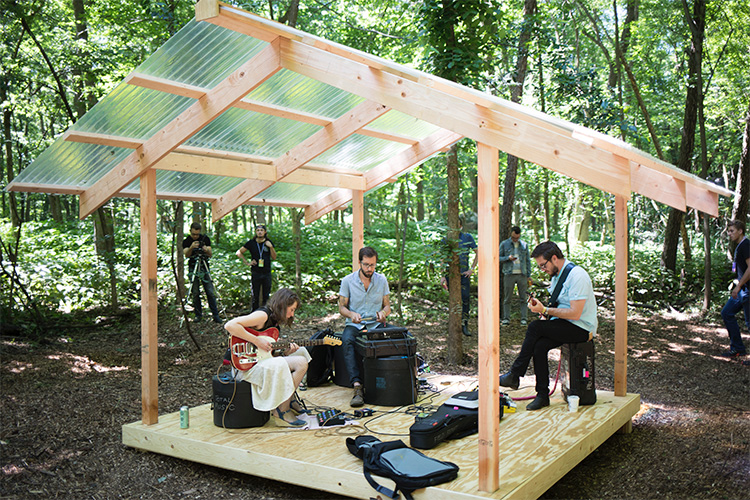
Photo: Kelly Michael Anderson
A month before EXC IV, Milwaukee singer/songwriter Caley Conway was recruited to join Field Report. Following a three-week crash course in their material, Conway partook in the artist-in-residence program and found herself in the Eaux Claires Women’s Choir alongside Julien Baker and Phoebe Bridgers. Conway opened The Trees stage with an improvised set joined by two of her Field Report bandmates, which they called Crumbs.
“The whole concept of what we were doing…I am pretty insecure about because I haven’t done a lot of playing in that style. I was really glad to have a chance to let music come out of me…and get in a groove with those guys, considering I had my first Field Report set with them later that day,” Conway told me.
“I was in total awe and wonder of that stage. I was so inspired watching those collaborative performances at the festival,” she added.
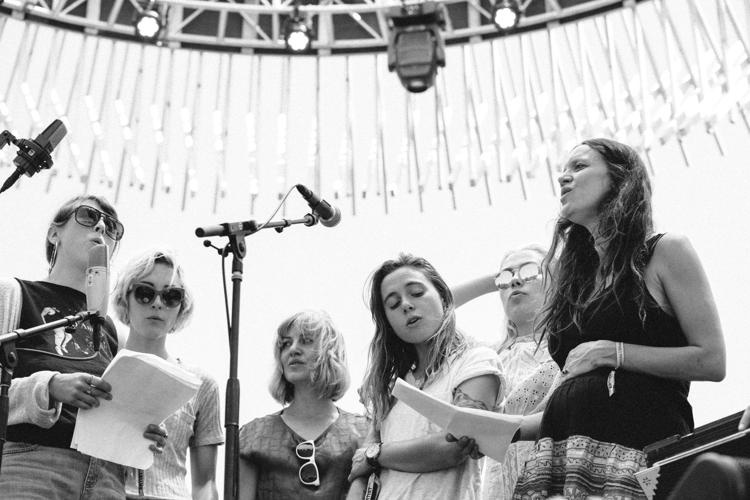
Photo: Zoe Prinds-Flash
Conway’s Field Report bandmate, Devin Drobka, an improv music veteran who co-founded the Unrehearsed MKE series and plays in the improv rock project Argopelter, echoed Conway’s appreciation for the artist-in-residence program at EXC IV.
“I have self-doubt sometimes, so to find a community of people from all over the world that are also pursuing this and putting themselves at the front lines in the true sense of an avant-garde, it feels really good to know that there are people for it,” Drobka told me.
Even the main stages at EXC IV offered singular experiences. Both nights were closed out by collaboration-heavy sets on the Lake Eau Lune stage. Chicago hip-hop artist Serengeti, who typically raps over beats on his iPod, was joined by Broder, Dessner, and other musicians on the House of IV stage.
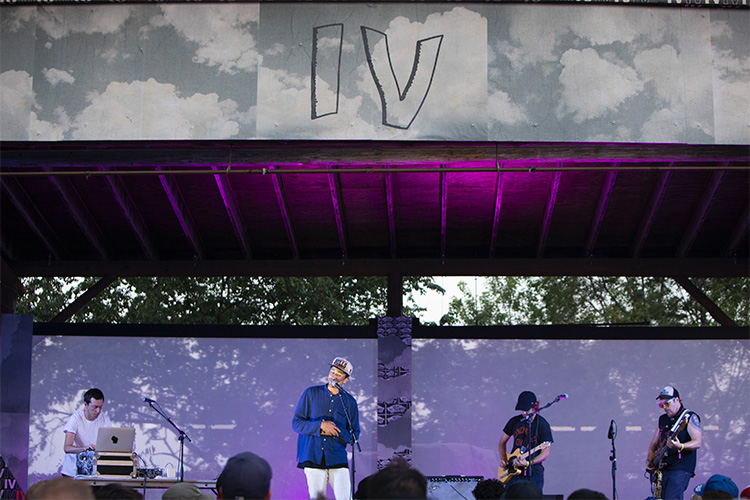
Photo: Kelly Michael Anderson
The Flambeaux stage was built exclusively for EXC IV. It was an in-the-round design by the same architect who created Dessner’s Long Pond recording studio in Hudson, New York. The National played The Flambeaux on the second night of EXC IV. The set featured a number of female guest vocalists, foreshadowing the female presence on the band’s excellent new album/film I Am Easy To Find.
The National’s set, like much of the weekend, included hugs. Artists who hadn’t seen each other for a while were reuniting and creating together. The gratitude was palpable. After four years, fans were starting to recognize and remember each other. There was a tangible sense of community on the grounds.
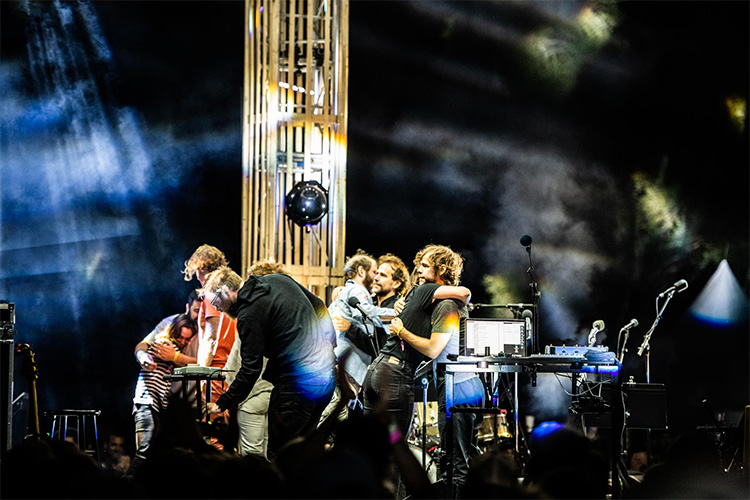
Photo: Graham Tolbert
“I always like to walk around at the festival and just experience it,” Francis told me.
“I used to work at this restaurant where the catch was that it was open ’til four in the morning and chefs from other restaurants would go and eat there. That was the hook, that’s the quick thing you could say about it.
“With Eaux Claires, you could walk around and feel good and experience it just like anybody else, even if you’re an artist. And every year I experienced some other performance that was truly magical.”
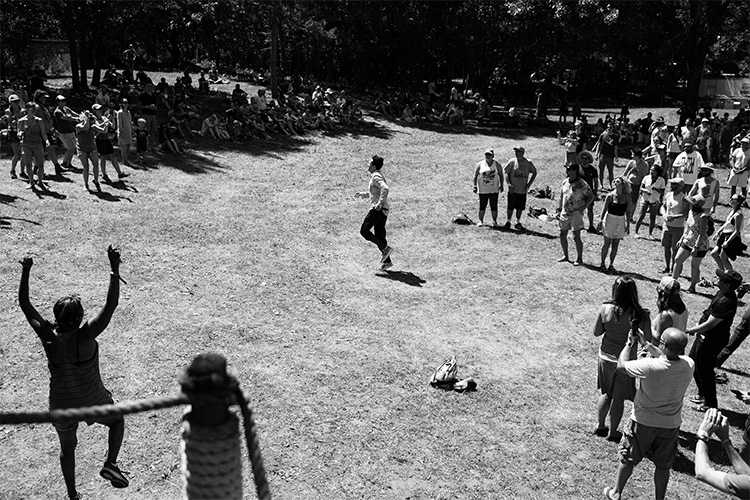
Photo: Zoe Prinds-Flash
It is Thursday, June 13, 2019. I am standing next to what was once known as The Creek stage. In the distance, an Eaux Claires art installation still stands. The festival has left a footprint—artifacts and ideas woven into the fabric of the region.
I drove out to Foster Farms following my impromptu interview with Francis. I was compelled to walk the grounds again. It’s private property, but the gates were open. A few men were working, I presume, on preparations for Country Jam USA, which predates Eaux Claires as a tenant of Foster Farms.
All around me, I could feel the ghosts of Eaux Claires past.
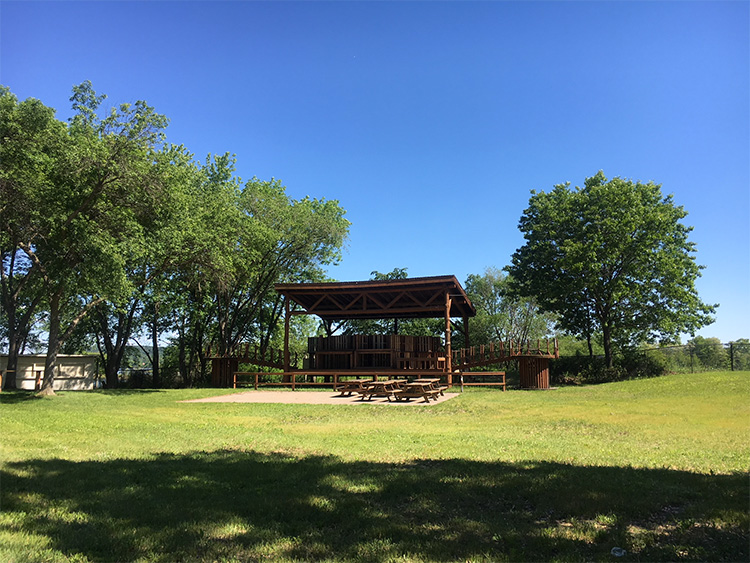
Photo: Joey Grihalva
Coincidentally, there were a handful of opportunities this summer to see Eaux Claires artists. Summerfest booked Bon Iver and The National back-to-back, as if it were some cosmic consolation for the absence of Eaux Claires. But the two festivals couldn’t be further apart.
At Summerfest, you could expect that when Julien Baker began her opening set for Bon Iver most of the crowd would either be filing in, getting drinks, or casually chatting.
At Eaux Claires, Baker might pop up on a stage in the woods, perform on the playable treehouse, or bring out the brilliant writer Hanif Abduraqqib during her main stage set.
Unpredictability is a part of what sets Eaux Claires apart.
Last month, Rosenau & Sanborn played The Back Room @ Colectivo. It was a solid show, but I had to focus to hear over back-of-the-room chatter and sounds coming from the cafe.
It paled in comparison to the first time I saw the duo perform. That was at EXC II inside of a geodesic dome, with the musicians on a thrust stage cloaked in transparent screens, onto which video art was projected, in front of an enraptured audience.
This summer, there was even an OXBEAUX III street festival. It expanded to two days, with local bands playing the first night. Rosenau & Sanborn played it the day after The Back Room gig, along with Alpha Consumer, Flock Of Dimes, Jenny Lewis, and another Justin Vernon project, The Shouting Matches.
We thought about going, but I had already signed up to sell my new book at Center Street Daze. In hindsight, I’m glad we stayed home. It would have been bittersweet to attend something that traditionally happened on the eve of Eaux Claires.
Yet, there I was, two months prior, standing on the grounds at Foster Farms. I could see myself sitting under a tree, catching some shade during Phoebe Bridgers main stage set at EXC IV, opening up Instagram and noticing a post from Michael Brown dated a few days before the festival began. It contained the hashtags #senioryear and #onelastrodeo.
The writing was on the wall.
Even before the negative reactions to EXC IV rolled in, the team had decided to call it quits at Foster Farms.
Brown later explained, “The harsh reality is that a large outdoor music festival either needs very large attendance—20,000 or more—or exorbitant ticket prices to be financially sustainable, neither of which fits our vision and goal for the purpose of this festival in Eau Claire.”
Which begs the question, what is the vision and goal for Eaux Claires?
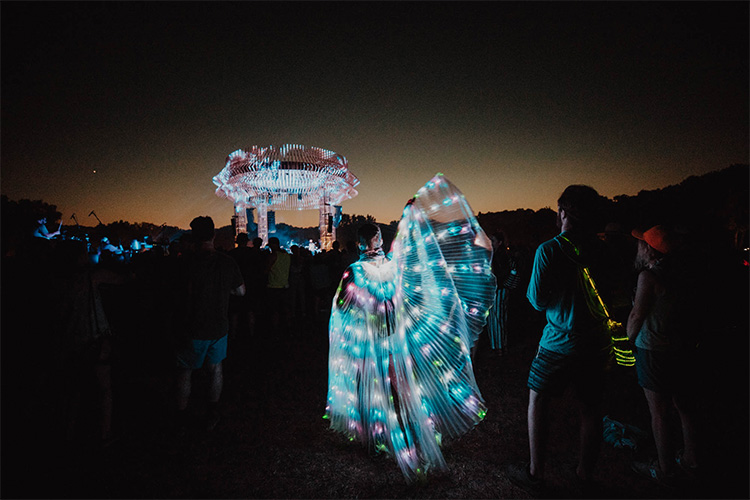
Photo: Scotify
While official festival literature has been characteristically cryptic, a press release from 2015 plainly laid out three principal goals.
“We at Eaux Claires have been driven by the idea that our festival would encourage music-genre-walls to melt away. That the barriers between the stage and the audience altered, and expression and experience put above all.”
Ahead of that inaugural outing, Vernon also sent personalized letters to each of the performers, asking them to step outside their comfort zone and embrace a collaborative ethos.
“We’ve done a lot of these and this is the first one that is actually a celebration of music,” said Nick Sanborn during Sylvan Esso’s euphoric set at the first Eaux Claires.
This sentiment was echoed in Cal Roach’s review of the festival for Milwaukee Record.
Out of the gates, Eaux Claires was exceeding in the “expression and experience above all” department.
During my conversation with Michael Brown, he told me that after watching the slick recap video of the first festival, the team felt it too closely resembled “what a music festival is supposed to look like,” and therefore considered it a creative failure.
In the years that followed, Eaux Claires refined and redefined the festival experience for both artist and audience. The emphasis on collaboration evolved into the week-long residencies preceding the third and fourth festivals.
In his coverage of the second year for Milwaukee Record, Roach pointed out that Bonnaroo and Lollapalooza both started out with an original, community-minded vision, but lost their identities in an attempt to draw bigger crowds. Eaux Claires has learned from these festivals and is working to avoid their trajectory.
Tired of the standard formulas and the pressure to expand the audience, Eaux Claires sought to flip the script.
When Michael Brown told me in 2017 that one of their goals was to eventually exist without a lineup announcement, I could appreciate the idea. I could see the festival being buoyed by a simple understanding that whatever the weekend holds will be worthwhile. They were building trust with the audience. But I didn’t believe they would actually attempt it the next year.
I’ll admit that when it happened, I fell prey to expectations. This is partly what fueled the negative reactions to EXC IV. There were also a few logistical hiccups. And as it goes with anything, the critical voices became the loudest online.
I must say that anyone complaining about a lack of household names and the abundance of Justin Vernon’s circle of friends at EXC IV had clearly not been paying attention to the festival.
“The founding musicians of Eaux Claires are really just one high school generation that grew up together and branched out to different cities or different projects, but stayed close and still work on music together,” said Michael Brown.
“The festival stems from a desire for all of them to come back together and work on something collaboratively. That was the seed of the original idea.”
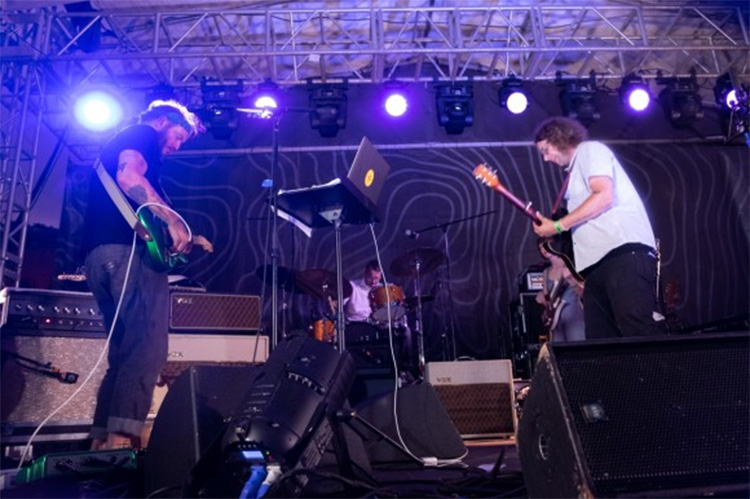
Photo: Mike O’Brien / Volume One
Creating an environment for inspiration is Eaux Claires forte.
As my fiancée walked into the inaugural festival, she realized that the multi-colored strings hanging above the gates were an art installation. This inspired her to re-contextualize her own installation work. After applying to EXC II and not getting in, she was given the opportunity to be an artist at EXC III. This led to commissions at festivals all over North America, mainly at multi-venue downtown events, which Eaux Claires is set to become in 2020.
It turns out, a downtown festival was actually Vernon’s initial idea for Eaux Claires. With the success of Prex Claires and OXBEAUX, the city is poised to become a strong partner. Local leaders believe the move will strengthen the festival’s roots in the community, provide more of an impact on the economy, make the festival more affordable, and allow for greater accessibility.
The Pablo Center at the Confluence offers a state-of-the-art building to center the activity around, including two world-class performance spaces.
“In many ways, there has been a stitched design from the inception,” said executive director Jason Jon Anderson about the relationship between the Pablo and Eaux Claires.
When he first got involved with the Pablo project, Anderson was working as Bon Iver’s production manager and oversaw conference and event services at UW-Eau Claire. Later, his staff of students would help produce Eaux Claires.
“The force and energy of the festival couldn’t wait for the building to be done, it needed to happen,” added Anderson.

Photo: Lee Butterworth
When I asked Francis how he felt when he got the news that Eaux Claires was taking 2019 off, his eyes got soft.
“I was sad…I understood though. I felt like the people who put it on worked so hard and gave so much of themselves to make it special for everyone who came. I understood that maybe they needed time…a year to regroup and to sort of rest with it.
“But yeah, my first thought was, ‘Damn, I gotta do a show in Eau Claire!’ Because it’s been so important to me…it’s an energy, so I definitely wanted to come feel it again.”
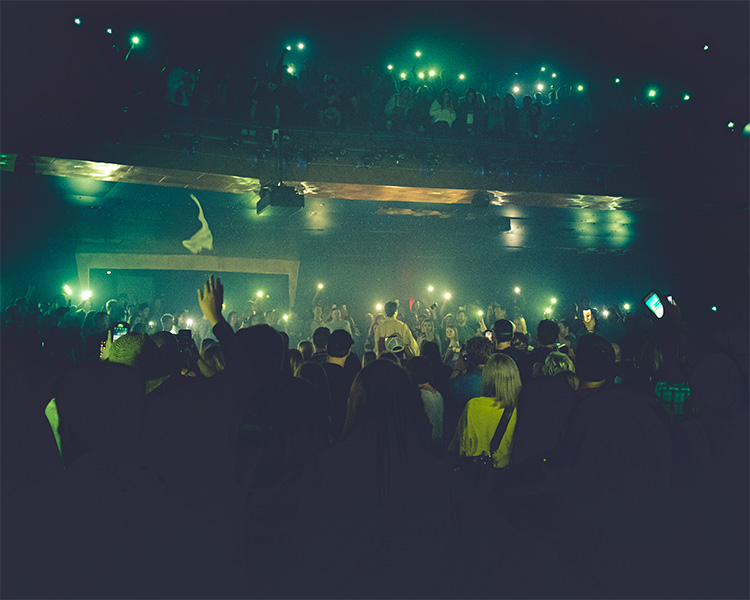
Photo: Lesley Keller
When the festival takes place next year, there will inevitably be nostalgia for the woods. But what unites the Eaux Claires faithful more than anything is an open heart and an open mind.
“The spirit of Eaux Claires was trying to do something extraordinary for a people and a place,” said Francis.
“You know, we can keep doing that. We can keep doing these extraordinary things.”
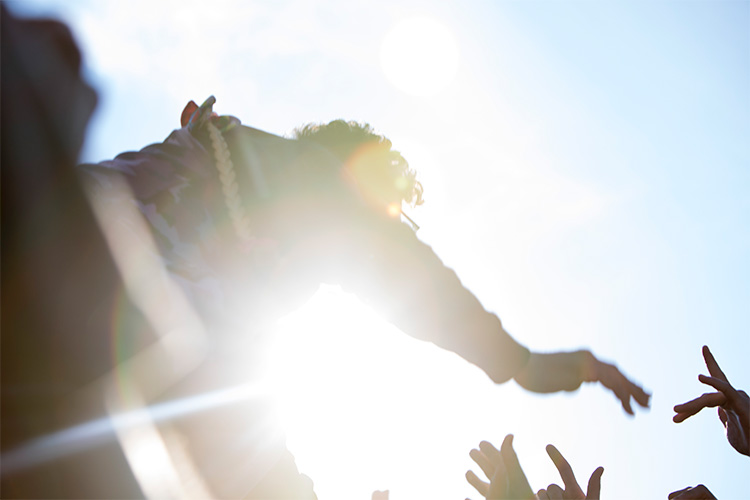
Photo: Kelly Michael Anderson
